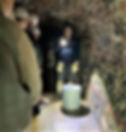Visiting the Victoria Tunnel, Newcastle
3 min readA great visit along part of a 19th century wagon way, built to transport coal to the Tyne river and later converted to an air raid...
A great visit along part of a 19th century wagon way, built to transport coal to the Tyne river and later converted to an air raid shelter in WWII. There is plenty to learn about its construction and operation, with some good human stories too.

You can take a 75 minute or 2 hour tour in small groups with very knowledgeable and enthusiastic volunteers. The 2 hour tour includes a short walk around this once heavily industrialised area, to help orientation when you go underground. Then the journey through the tunnel begins at the entrance in Ouseburn where visitors are issued with hard hats and torches. Chronologically the story is reversed, with the first half of the tour looking at the tunnel’s vital part in sheltering the citizens of Newcastle from German bombs, the second half focusing on its use to transport coal from the Leazes Main colliery to the river.

The start of the tour
The guides explain that before war began in 1939 plans had already been made to open up the defunct tunnels to protect people – for the most part Newcastle residents had no gardens for Anderson shelters, and Morrison shelters were unsuitable for sprawling tenement blocks.
It took two weeks for engineers to find out how to access the tunnels. The higher levels had to have blast walls added because of the dangers of a bomb blast so near the surface. Once the level was more than 55 feet down it was deemed to be safe – it was not possible even to hear the planes or bombs, nor indeed the All Clear which had to be sounded by wardens’ whistles.
A nurses’ station was positioned as soon as the area was safe, where patients were triaged in very little light. Nearby the wall was painted with canary yellow paint – gas detection paint, which would turn pink if gas got down into the tunnel. Bombing was heavy over Newcastle because of the many factories and docks in the North East. People could be down there for up to 10 hours as bombers coming back, using the river as navigation, would drop any unspent bombs on the city below.
141 people lost their lives in the bombing: the number would undoubtedly have been far greater without this vital shelter. 7000 people could be down there at any one time but there were wooden seats for only 2500. 500 3 tier bunk beds were provided with a strict hierarchy of users – kids on the top, pregnant or nursing mothers in the middle, essential war workers on the bottom.

The Elsan Toilet
The toilet facilities are pointed out – an Elsan bucket – and it is explained that the only things to make this any easier was a modesty hessian curtain and plenty of strong smelling disinfectant.
When the guides encourage the group to briefly turn out their torches, you get just a little glimpse of the horror this whole experience must have been for those compelled to dive underground into these damp dark tunnels night after night.
Passing under Hadrian’s Wall, the story then goes backward in time to the construction of the tunnel. In 1839 there were coal mines everywhere and the coal was usually transported by horse drawn carts trundling through the centre of town, then being offloaded on to barges before eventually being taken to the coal ships waiting at the mouth of the Tyne. Two enterprising mine owners employed firstly an engineer and then 200 clay kickers to dig out the clay (later recycled into the bricks that line the tunnel). They then installed rails and eight wagons and used a simple system combing gravity and a stationary steam engine to move the coal directly to the ships. A masterpiece of engineering, opened in 1842 which could run 24 hours a day and saved 90% on transport costs. It operated until the colliery closed in 1860.
There are plenty of good stories, including of the only unfortunate death within the tunnel, and the volunteers are happy to answer any questions. There is plenty of humour and fun within their delivery: they clearly enjoy enlightening and entertaining their visitors. 15,000 people now visit the tunnels every year – testament to their great success.
Address: 53/55 Lime Street, Ouseburn Valley, Newcastle upon Tyne NE1 2PQ
The tours are run by the Ouseburn Trust and tickets have to be booked in advance through the website >>



